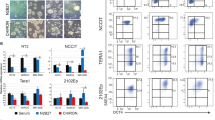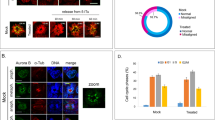Abstract
Embryonal carcinoma (EC) stem cells are thought to be equivalent to the ectoderm of the preimplantation mouse embryo because they share morphological, biochemical and antigenic properties1,2. These near diploid EC cells can be induced to differentiate into cell types of all three germ layers1,2. They also can take part in normal differentiation and contribute cells to many tissues in chimaeric mice derived from preimplantation mouse embryos injected with them3. The ability to restrict the growth of certain viruses is a distinguishing characteristic of EC cells4–8, but it is intriguing that this restriction disappears after differentiation. The ability of EC cells to block totally productive infection by the highly infectious and oncogenic Moloney strain of murine leukaemia virus (M-MuLV) is remarkable, as virtually all other murine cells are permissive to the growth of this virus. Teich et al.7 suggested that replication of M-MuLV in EC cells is blocked at some point after integration of pro viral DNA into the cell's genome. Here I enquire into the dominant or recessive nature of the restriction, that is, do EC cells show transdominant inhibition of virus replication analogous to that imposed by interferon or the mouse Fv-l locus, or is the block to MuLV replication due to the lack of something in the EC cell? This report shows that the restriction of M-MuLV in EC cells can be overcome by fusion with permissive cells. The resulting complemented growth of M-MuLV in EC/permissive cell heterokaryons indicates that the restriction over M-MuLV is a recessive trait of EC cells and, therefore, defines a hitherto unknown host function that is vital to virus growth but missing in EC cells.
This is a preview of subscription content, access via your institution
Access options
Subscribe to this journal
Receive 51 print issues and online access
$199.00 per year
only $3.90 per issue
Buy this article
- Purchase on Springer Link
- Instant access to full article PDF
Prices may be subject to local taxes which are calculated during checkout
Similar content being viewed by others
References
Martin, G. R. Cell 5, 229–243 (1975).
Hogan, B. L. M. Int. Rev. Biochem. 15, 333–376 (1977).
Mintz, B. & Illmensee, K. Proc. natn. Acad. Sci. U.S.A. 72, 3585–3589 (1975).
Swartzendruber, D. E. & Lehman, J. M. J. cell. Physiol. 85, 179–188 (1975).
Kelly, F. & Boccara, M. Nature 262, 409–411 (1976).
Peries, J., Alves-Cardoso, E., Canivet, M., Debons-Guillemin, M. C. & Lasneret, J. J. natn. Cancer Inst. 59, 463–465 (1977).
Teich, N. M., Weiss, R., Martin, G. R. & Lowy, D. R. Cell 12, 973–982 (1977).
Miller, R. A., Ward, D. C. & Ruddle, F. H. J. cell. Physiol. 91, 393–402 (1977).
Schnitzer et al. J. Virol. 23, 449–454 (1977).
Gautsch, J. W., Elder, J. H., Schindler, J., Jensen, F. C. & Lerner, R. A. Proc. natn. Acad. Sci. U.S.A. 75, 4170–4174 (1978).
Emanoil-Ravicovitch, R., Robert, J., Cavinet, M., d'Auriol, L. & Peries, J. C.r. Séanc. Hebd. Acad. Sci., Paris 286, 1277–1280 (1978).
Huebner, K., Tsuchida, N., Green, C. & Croce, C. J. exp. Med. 150, 392–405 (1979).
Miller, R. A. & Ruddle, F. H. Cell 9, 45–55 (1976).
Speers, W. C., Gautsch, J. W. & Dixon, F. (in preparation).
Swartzendruber, D. E., Friedrich, T. D. & Lehman, J. M. J. cell. Physiol. 93, 25–30 (1977).
Boccara, M. & Kelly, F. Virology 90, 147–150 (1978).
Segal, S., Levine, A. J. & Khoury, G. Nature 280, 335–338 (1979).
Segal, S. & Khoury, G. Proc. natn. Acad. Sci. U.S.A. 76, 5611–5615 (1979).
Jakob, H., Boon, T., Gaillard, J., Nicolas, J. F. & Jacob, F. Ann. Microbiol. Inst. Pasteur 124 B, 269–282 (1973).
Hartley, J. W. & Rowe, W. P. Virology 65, 128–134 (1975).
Elder, J. H. et al. Proc. natn. Acad. Sci. U.S.A. 74, 4676–4680 (1977).
Gautsch, J. W. & Meier, H. Virology 72, 509–513 (1976).
Davidson, R. L. & Gerald, P. S. Somat. Cell Genet. 2, 165–176 (1976).
Gautsch, J. W., Bedigian, H. G. & Meier, H. Virology 83, 462–466 (1977).
Speers, W. C., Birdwell, C. R. & Dixon, F. J. Am. J. Path. 97, 563–578 (1979).
Bernstine, E. G., Hooper, M. L., Grandchamp, S. & Ephrussi, B. Proc. natn. Acad. Sci. U.S.A. 70, 3899–3903 (1973).
Author information
Authors and Affiliations
Rights and permissions
About this article
Cite this article
Gautsch, J. Embryonal carcinoma stem cells lack a function required for virus replication. Nature 285, 110–112 (1980). https://doi.org/10.1038/285110a0
Received:
Accepted:
Issue Date:
DOI: https://doi.org/10.1038/285110a0
This article is cited by
-
Hemato-endothelial differentiation from lentiviral-transduced human embryonic stem cells retains durable reporter gene expression under the control of ubiquitin promoter
Cytotechnology (2010)
-
Delayed de novo methylation in teratocarcinoma suggests additional tissue-specific mechanisms for controlling gene expression
Nature (1983)
-
Lack of retrovirus gene expression in teratocarcinoma stem cells is limited to the nucleus
Somatic Cell Genetics (1982)
Comments
By submitting a comment you agree to abide by our Terms and Community Guidelines. If you find something abusive or that does not comply with our terms or guidelines please flag it as inappropriate.



